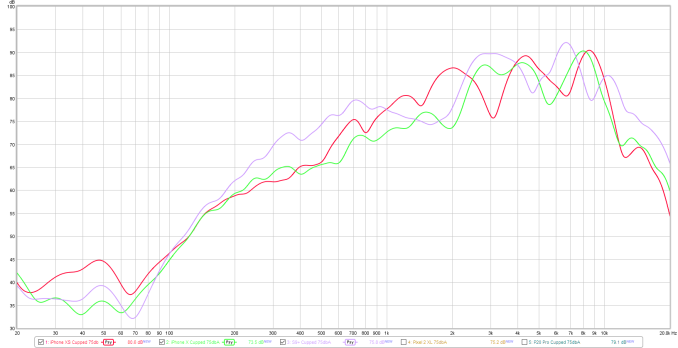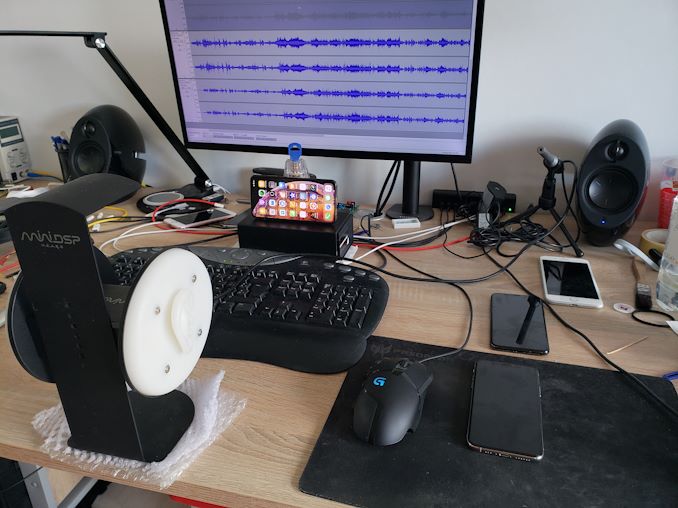The iPhone XS & XS Max Review: Unveiling the Silicon Secrets
by Andrei Frumusanu on October 5, 2018 8:00 AM EST- Posted in
- Mobile
- Apple
- Smartphones
- iPhone XS
- iPhone XS Max
Camera Video Recording
In terms of video recording, the iPhone XS promises an improved dynamic range in modes up to 30fps. What this likely means is that the phone’s able to capture in HDR mode in the 30fps modes, doing the same kind of processing we also see in SmartHDR still pictures.
Also something I’ve dreaded on iPhones for years; the new iPhone XS finally introduces stereo audio recording. Why it took Apple such a long time to finally introduce stereo recording is something that boggles the mind, but, let’s not complain, as we now finally have it on the new generation.
iPhone XS: iPhone X:
Comparing the iPhone XS video to the iPhone X, there’s one thing that is immediately very evident: the new XS is able to produce much better image stabilisation than last year’s flagship. Indeed, it looks like Apple vastly improved the OIS/EIS on the new phones, as the wobble that happens when walking is gone on the XS.
Audio recording finally is up to par, and we can hear the wind and rustling leaves of the trees around us. I think Apple might still have to work a bit on the wind noise cancellation, as in some parts the audio sounded as if it was inside a tube.
In terms of image quality, Apple’s claims of the improved dynamic range are very much verified. The phone showcases a lot more brought down highlights in the scene, and in darker areas, show better shadows. It’s unfortunate that this is limited only to the 30fps modes, but it’s understandable.
Switching over from the main lens to the telephoto lens happens relatively fast, although with a short exposure flash and a slight delay on the first zoom. 4K60 recording doesn’t allow for the use of the telephoto lens.
All in all, the video recording quality of the new iPhone XS is massively improved in all areas of stabilisation, picture quality, and audio. 4K30 recording on the XS is probably the best I’ve seen on any smartphone – a definitive applause to Apple for the improvements here.
Speaker Evaluation
Apple claimed to have improved the speaker audio quality on the new iPhone XS, allowing for more stereo separation and filling sound. I had introduced a new speaker evaluation method a few months ago because this year’s efforts by smartphone vendors to improve speaker quality has been very pronounced, and I wanted to have a way to objectively convey these improvements.
Starting off with speaker loudness, we’re measuring the phones at maximum volume, both in one-hand portrait mode, as well as two-handed mode where the palms are cupped towards the user. These two use-cases are what I find myself most often using the phone’s speakers in, so hopefully that also represents how most users use it as well, please let me know otherwise!

Using a pink noise signal, the iPhone XS pretty much falls into line with the results of the iPhone X, coming in at a very loud 82.8dBA in portrait mode and 87.6dbA in two-handed mode. Apple’s sound directionality on the iPhone X and XS is among the best, most likely due to the fact that the stereo earpiece is among the loudest of current generation smartphones.
Measuring the frequency response of the speakers, we see the iPhone XS closely following the measurement of the iPhone X, however there’s a major difference in the mid-range where the XS is around 5dB louder, raising instrumental frequencies and voices. This difference is what I think Apple is referring to when talking about better “fullness”, as it is evident when playing back media.
To better demonstrate the difference between the phones, I’ve attempted to capture them with a binaural microphone setup. Now I know my environment isn’t perfect as I don’t have the necessary sound dampening equipment, but I hope it does serve as an overall adequate A/B comparison between the phones. I’ve tried to calibrate the sound as much as possible recorded by the setup to a flat frequency response, although I’m sure there are improvements to be made. As a comparison, I also included calibrated speakers as a baseline to get an idea of the microphone setup.
The audio is meant to be listened to with headphones, or even better with IEMs, as this will give the intended playback of the binaural recording.
The iPhone XS’ improvements in the mid-range are quite evident as voices sound deeper and more pronounced on the new phone. Stereo separation is also quite good – resulting in a filling audio experience.
I included the S9+ and G7 as comparison devices. Samsung still does a significantly better job at the low-mid ranges which gives the phone more overall presence than the iPhones, also has an advantage in the very high frequencies giving more clarity, however the new iPhone’s XS strength point in the mid-ranges is the S9’s weakness, and vocals sound a lot less present than on the XS.
As for the G7, I just wanted to showcase a mono speaker device, and just how huge the audio difference is. Unfortunately the G7, even though it promises to have a good speaker, fails in practice.












253 Comments
View All Comments
Constructor - Monday, October 8, 2018 - link
Sure you can – just go to airplane mode and re-enable WiFi.s.yu - Monday, October 8, 2018 - link
In the third and fifth low light sample I think it's pretty clear that the XS beat the P20P, again P20P's retention of texture is horrible and only in extreme low light (second and last sample) and scenes with many man-made objects which lack obvious texture (third sample) does its excessive sharpening and NR have a advantage. The first sample is a surprise, there either the scene is actually darker than I'm lead to believe or there's something else I've not taken into account.daiquiri - Monday, October 8, 2018 - link
Isn't this a too bold affirmation that A12 is on par with current desktop CPUs? So why didn't we stack them in order to have 5x the processing power of a common laptop/workstation for 1/2 of the power? What am I missing here? Because this doesn't make much sense to me.If I have 2 or 3 of these SoC chips and photoshop running on them will I have my filters running faster? Chrome loading webpages faster? Creating zip archives or converting flac files 3x times faster than an Intel I7?
resiroth - Monday, October 8, 2018 - link
There is widespread speculation (and at this point, it is considered more likely than not) that apple will transition to their own chips exclusively for their Mac products in the near future (within 2 years).What exactly doesn’t make sense to you?
Ps: will be very interesting to see results of new iPad Pro this year too.
daiquiri - Monday, October 8, 2018 - link
What is strange to me is why aren't we already stacking this SoCs. I suppose I can fit 6 or 8 of these processors on the same die size. This means I would have a lot faster PC for less power? It they are that great why aren't on desktops already?Does this mean if I manage to install Windows 10 ARM edition on my PC photoshop will run faster and Chrome will load pages two or three times faster since I have 8 of these SoCs on my desktop pc?
Constructor - Wednesday, October 10, 2018 - link
Because just increasing the core count is not quite enough.As I have explained above, a platform transition is a massive undertaking which among many other things needs actually superior performance to afford the initially still necessary legacy code emulation.
This will almost certainly start at a WWDC (next year or the year after that, most likely) with an announcement about not just coming hardware but also about those new mechanisms in macOS itself, and actual Axx-powered Macs may take months after that to emerge while developers start porting their code to the new platform.
It's not as if this was the first time for Apple – they've done it twice already!
varase - Tuesday, October 23, 2018 - link
Yeah, but they always went to a *much* faster CPU to do the emulation.Constructor - Wednesday, October 24, 2018 - link
Even just the iPhone cores right now are already at about a desktop i5 level according to GeekBench.There should be quite some room for upscaling with more power and better cooling.
tipoo - Wednesday, October 24, 2018 - link
These cores are 30% larger than Intels, let that sink in.I'm sure 8 of them would perform marvellously, for the cost. And it may be coming.
Zoolook - Tuesday, October 9, 2018 - link
I just pulled an old test of a i3-6320, a 3 year old dual-core, and the A12 does good on some of the tests, but in many tests it's quite a bit behind, so it's not ready for server-duty yet.I know that the i3 has higher frequencies but it's also only two cores, compared to 2+4.
There is no question that the big cores are very efficient, but they are optimized for their current job.
If Apple would build a 6- or 8-core processor based on their large cores and throw away most of the other SoC and add other parts (stronger SIMD etc), yes then we might have a good desktop/serverchip, but the A12 is not that chip.
Also remember that we are comparing 14nm Intel chips with the newest "7nm" process, if Intel ever gets their 10nm process up and running for real, then we could do a better comparison.